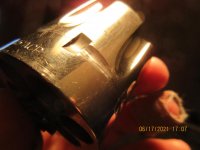Mark Soderquist
Plastic
- Joined
- Feb 24, 2022
Follow along with the video below to see how to install our site as a web app on your home screen.
Note: This feature may not be available in some browsers.
Mostly a HSS is hard and a thing that it won't cut must be harder so Carbide is needed.
The time that this is not true is when the HSS cutter is hard enough..but the fixturing is not solid enough to resist cutting forces, so the HSS cutter quickly dulls.
One test is to strike a part with a file, if the file can cut the part then a proper set-up should allow HSS.
At a certain part hardness, the carbide cutter can be a cost-saving.
The part held in the lathe photo (post 17) would be considered a poor set-up.
A skilled machinist would put a mill jack under the part if forces were toward the table
If the cutting forces were to the cross direction, then an angle plate would be placed/bolted in the go-direction to bump solid the part perhaps with the angle plate touching or with an adjustment screw to bump the part.
The set-up shown would be poor with a HSS or carbide cutter.
I usually consider a mill fixture should be made of 1/2" stock.
Grinding fixtures often can be 3/8 stock if not too long..

How do you index for milling the next notch?
Making that setup more solid would not be my choice, I would put the cylinder on the machine centerline and then index the next notch.
The simplest improved setup might be to wrap the cylinder with heavy-duty (6 Mill) masking tape and put it into the lathe chuck jaws...Might also add a fine thread brass screw touch to the go direction.
Very handy would be to have an index of some sort so with making the first location good, you could just 6 index to the next position.
 Second pic is a Bob Munden cylinder which is better the lead is tapered on the curve
Second pic is a Bob Munden cylinder which is better the lead is tapered on the curve

QT: [After your advice, I am thinking of a way to run a second fixture through the opposite chamber and fasten it to ]
So still 3 setups, seems a waste of time and chance for error.
The correct set-up is to fixture it once and then index it to the other locations.
with one part chucking at the center. and using a 6 place index so each next index would match the first setting.
with one part chucking at the center. and using a 6 place index so each next index would match the first setting.
Notice
This website or its third-party tools process personal data (e.g. browsing data or IP addresses) and use cookies or other identifiers, which are necessary for its functioning and required to achieve the purposes illustrated in the cookie policy. To learn more, please refer to the cookie policy. In case of sale of your personal information, you may opt out by sending us an email via our Contact Us page. To find out more about the categories of personal information collected and the purposes for which such information will be used, please refer to our privacy policy. You accept the use of cookies or other identifiers by closing or dismissing this notice, by scrolling this page, by clicking a link or button or by continuing to browse otherwise.
